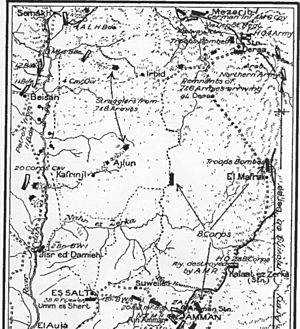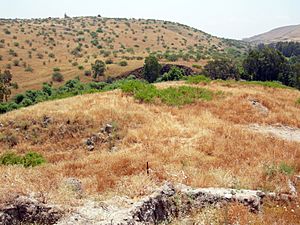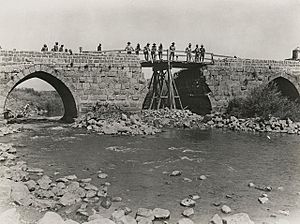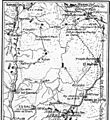Battle of Jisr Benat Yakub facts for kids
Quick facts for kids Battle of Jisr Benat Yakub |
|||||||
|---|---|---|---|---|---|---|---|
| Part of the Middle Eastern theatre of World War I | |||||||
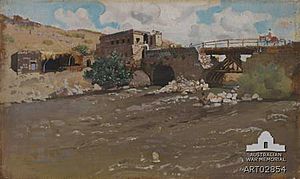 "Jisr Benat Yakub: bridge repaired by Australian Unit" by George Lambert, shows the repaired bridge and buildings at the western end of the bridge in 1919 |
|||||||
|
|||||||
| Belligerents | |||||||
| Commanders and leaders | |||||||
| Units involved | |||||||
| Egyptian Expeditionary Force Desert Mounted Corps Australian Mounted Division |
Tiberias Group formed from surviving Yildirim Army Group garrisons which retreated from Samakh and Tiberias and reinforcements from Damascus | ||||||
The Battle of Jisr Benat Yakub happened on September 27, 1918. It was a key moment during World War I in the Middle East. This battle was part of a big chase by the Desert Mounted Corps (mostly Australian and British soldiers). They were pursuing the retreating Ottoman and German armies towards Damascus.
This fight took place after the Battle of Megiddo, a major victory for the Allied forces. The Australian Mounted Division attacked and captured several defensive spots. These spots were held by German and Ottoman soldiers. They were located at the Daughters of Jacob Bridge (also known as Jisr Benat Yakub) and nearby river crossings. This bridge was very important because it crossed the Jordan River.
The remaining Ottoman armies were trying to escape towards Damascus. They were being chased by the Australian Mounted Division and the 5th Cavalry Division. The Ottoman soldiers who survived earlier battles tried to set up defenses on the eastern side of the Jordan River. Their goal was to protect the main retreating army. However, the Australian Mounted Division successfully attacked these defenses. They captured many soldiers and took control of the eastern bank of the Jordan River. After this victory, the Allied forces continued their advance towards Damascus.
Contents
Why Was This Battle Important?
The Jordan River Crossing
The Jordan River was a very important natural barrier. There was only one good place to cross it at the southern end of the Hula Valley. This crossing point is known as Jacob's Ford. Over time, bridges were built here, leading to its Arabic name, Jisr Benat Yakub, meaning "Daughters of Jacob Bridge."
This location has been important for thousands of years. Ancient trade routes passed through here. Many different groups, like the Egyptians, Assyrians, Hittites, Jews, Saracen Arabs, Crusaders, and Ottomans, had all crossed the river at this spot. In 1179, the famous leader Saladin destroyed a castle built by the Crusaders here. Even Napoleon's army reached this bridge in 1799.
The Retreat of the Ottoman Army
After a big defeat at the Battle of Megiddo, the Ottoman and German armies began to retreat. Their commander, Otto Liman von Sanders, ordered his troops to pull back towards Damascus.
About 6,000 to 7,000 German and Ottoman soldiers were trying to escape. They moved through places like Tiberias and Deraa towards Damascus. The Allied forces, especially the Australian Mounted Division, were right behind them.
The Battle Begins
The Australian Mounted Division, with the 5th Cavalry Division following, left Tiberias early on September 27. They were heading north towards Damascus. They reached the area around Jisr Benat Yakub, the Daughters of Jacob Bridge, around midday.
The Ottoman and German soldiers had set up strong defensive positions. They used machine guns to control the area around the bridge and river crossings. The river itself was deep and fast, making it hard to cross, especially with enemy fire. These defenses stretched from the bridge north towards Lake Huleh.
Fighting at the Bridge
At Jisr Benat Yakub, a French cavalry unit, part of the 5th Light Horse Brigade, attacked the buildings near the western end of the bridge. They rode across open ground and then fought on foot. They faced heavy machine gun fire and suffered some losses.
The 4th Light Horse Brigade's Machine Gun Squadron also joined the fight. They helped to put pressure on the Ottoman defenses. The fighting continued into the night. By early morning on September 28, the bridge area was clear, and Allied troops began to cross.
Crossing the River at El Min
Meanwhile, other parts of the 5th Light Horse Brigade, including the 14th Light Horse Regiment, looked for another place to cross the river. They found a ford (a shallow place to cross) about 1.5 miles south of the bridge, near El Min.
In the late afternoon, they swam their horses across the river. However, the ground on the other side was rocky, and it was getting dark. They had to stay put until morning. Later, the 12th Light Horse Regiment also crossed the river at El Min to secure the area.
Two soldiers from the 4th Light Horse Regiment were recognized for their bravery during this crossing. Farrier Quarter Master Sergeant Frederick Gill helped with the horses under heavy fire. Trooper George Stockdale went on a dangerous scouting mission to find the enemy's positions.
Moving Towards Lake Huleh
While this was happening, the 3rd Light Horse Brigade moved north along the western bank of the Jordan River. They were looking for another crossing point near Lake Huleh. The 9th Light Horse Regiment fired on the enemy from the west bank.
The 10th Light Horse Regiment managed to cross the river at dusk. They captured a strong enemy position, taking 50 prisoners and three guns. The 8th Light Horse Regiment followed them across the river.
The main Ottoman forces at Jisr Benat Yakub realized they were in danger of being surrounded. This forced them to retreat quickly, many of them in trucks. The Allied forces captured 53 more prisoners.
After the Battle
The Chase Continues
The 3rd Light Horse Brigade continued their advance after crossing the Jordan River. They moved about 4 miles to cut the road to Damascus at a place called Deir es Saras. However, the main Ottoman forces had already retreated from Jisr Benat Yakub.
At Deir es Saras, the Allied soldiers met another strong group of Ottoman defenders. The "B" Squadron of the 10th Light Horse Regiment bravely charged them on horseback. They captured the position, taking 12 German and 41 Ottoman prisoners, along with a field gun, a machine gun, a truck, and an ammunition dump.
Repairing the Bridge
While the cavalry units crossed the river by swimming or using fords, their vehicles and heavy guns needed the bridge to be repaired. The Ottoman forces had blown up one of the bridge's arches.
Engineers from the Desert Mounted Corps worked through the night. They used timber to build a temporary bridge over the destroyed section. In just five hours, they built a strong wooden support structure.
By the morning of September 28, the Australian Mounted Division had crossed the river and was moving along the road towards El Kuneitra. Soon after, their vehicles and guns followed, crossing the newly repaired bridge. The chase towards Damascus continued.
Images for kids


